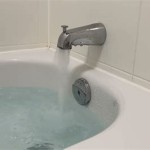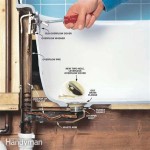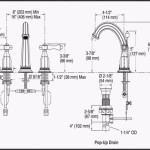How to Keep Your Bathtub Water Hot
Maintaining a consistent and comfortable water temperature in a bathtub is a common concern for bath enthusiasts. A long, relaxing soak can quickly become an unpleasant experience if the water rapidly cools down. Several factors contribute to heat loss in bathtubs, including ambient air temperature, the material of the tub itself, and the initial temperature of the water. Understanding these factors and implementing strategies to mitigate heat loss can significantly improve the bathing experience.
The rate at which a bathtub loses heat is governed by basic principles of thermodynamics. Heat transfer occurs primarily through conduction, convection, and radiation. Conduction involves the transfer of heat through direct contact with a cooler substance, such as the tub material itself or the surrounding flooring. Convection is the transfer of heat through the movement of fluids (in this case, air), as warmer air rises and cooler air replaces it, carrying heat away from the water's surface. Radiation is the emission of heat energy in the form of electromagnetic waves, which is less significant than conduction and convection in a typical bathroom environment, but still contributes to heat loss.
The material of the bathtub plays a substantial role in how quickly the water cools down. Materials with high thermal conductivity, such as cast iron, will initially feel cold to the touch and draw heat away from the water more rapidly. Acrylic tubs, while often feeling warmer initially, can still lose heat relatively quickly, especially if they are thin or uninsulated. Factors outside the tub itself such as bathroom insulation and ventilation also contribute to heat loss. Bathrooms that are poorly insulated and have significant air leaks will exacerbate the cooling process.
Preheating the Bathtub
Preheating the bathtub before filling it is a simple yet effective method for minimizing heat loss. Running hot water into the tub for a few minutes before starting the bath warms the tub's surface, reducing the temperature difference between the tub and the water that fills it. This reduces the initial shock of the hot water contacting a cold surface and minimizes the amount of heat that is immediately absorbed by the tub material. Letting the hot water sit for a few minutes to thoroughly warm the tub is recommended. This practice is particularly beneficial for tubs made of materials with high thermal conductivity, such as cast iron or steel.
The effectiveness of preheating can be enhanced by using a stopper to retain the hot water used for preheating. Once the tub is sufficiently warm, drain the water and then proceed to fill the tub for the bath. The initial preheating step will have reduced the thermal gradient between the tub and the bathwater, resulting in a slower rate of cooling. Additionally, it is crucial to ensure that all fixtures and plumbing connected to the tub are also preheated to further minimize heat loss through conduction.
Insulating the Bathtub
Insulating the bathtub is a more involved but highly effective approach to maintaining water temperature. Insulation minimizes heat transfer through the tub's surfaces, significantly slowing down the rate at which the water cools. Several insulation methods can be employed, depending on the type of tub and the accessibility of its exterior surfaces.
For drop-in tubs or those with exposed sides, applying fiberglass insulation batting or spray foam insulation to the exterior surfaces is a common and effective method. Fiberglass batting can be cut to size and carefully fitted around the tub, ensuring that all accessible surfaces are covered. Spray foam insulation offers a more complete seal, filling in gaps and crevices that batting might miss. It is essential to follow safety guidelines when applying spray foam insulation, ensuring proper ventilation and wearing appropriate protective gear. Rigid foam boards can also be cut to size and affixed to the tub's exterior using construction adhesive. This method provides a more durable and water-resistant insulation layer compared to fiberglass batting.
Another option is to use a bathtub insulation blanket, which is specifically designed to wrap around the tub and provide thermal insulation. These blankets are typically made of reflective foil-backed material that reflects heat back into the tub, further reducing heat loss through radiation. Ensure that the insulation material is installed properly to avoid moisture accumulation, which can lead to mold growth and reduce the effectiveness of the insulation. Proper sealing and ventilation around the insulated areas are crucial for long-term performance and preventing water damage.
For freestanding tubs, insulation options are more limited, but wrapping the exterior with a decorative insulated wrap or blanket can provide some degree of insulation. Furthermore, consider the location of the tub. Placing a tub in an area that is prone to drafts or that has significant temperature fluctuations will increase heat loss. Sealing any drafts around windows and doors in the bathroom will also help maintain a more consistent temperature and reduce heat loss from the tub.
Maintaining Water Temperature During the Bath
Even with preheating and insulation, the water in a bathtub will gradually cool over time. Implementing strategies to maintain the water temperature during the bath can significantly extend the enjoyment of the experience. One of the simplest methods is to periodically add hot water to the tub. This can be done by carefully opening the faucet and allowing hot water to flow into the tub, being mindful to avoid scalding. To maintain a consistent temperature, add small amounts of hot water frequently, rather than adding large amounts at once.
Another approach is to use a bathtub water heater. These devices are submerged in the bathwater and designed to slowly heat the water to maintain a desired temperature. Ensure that any electric immersion heater used in the bathtub is specifically designed for this purpose and adheres to all safety regulations. Never use a general-purpose immersion heater in a bathtub, as this poses a significant electrical hazard. Prior to attempting to use a bathtub water heater, contact a qualified electrician.
Covering the bathtub water surface can significantly reduce heat loss through evaporation. A simple solution is to cover the tub with a bath sheet or a towel when not actively using the water. Specialized bathtub covers are also available, designed to fit snugly over the tub and provide insulation. These covers can be particularly effective in retaining heat and reducing evaporation, especially in larger bathtubs. Bath bubbles and bath oils can also create a thin barrier on the water's surface, reducing the rate of evaporation. This barrier helps to trap heat and keep the water warmer for a longer period.
Consider the ambient temperature of the bathroom. A colder bathroom will accelerate heat loss from the bathtub water. If possible, increase the bathroom temperature before taking a bath, using a space heater or adjusting the central heating system. A warmer bathroom will reduce the temperature difference between the water and the surrounding air, slowing down the rate of cooling. Avoid drafts in the bathroom by sealing any gaps around windows and doors. Close the bathroom door to prevent cold air from entering from other parts of the house. Additionally, install a heated towel rack to keep towels warm and ready for use after the bath. This will help prevent a rapid decrease in body temperature when exiting the warm water.
Choosing the right type of bathtub can also contribute to maintaining water temperature. As previously mentioned, tubs made of materials with lower thermal conductivity, such as acrylic or composite materials, will generally retain heat better than tubs made of cast iron or steel. Look for tubs that are specifically designed with insulation features, such as a layer of foam or other insulating material applied to the exterior surfaces. Consider the size and shape of the bathtub. Smaller tubs will generally lose heat more slowly than larger tubs, as there is less surface area for heat transfer. A deeper tub may also help to keep the water warmer for longer, as the greater volume of water will retain heat more effectively. The overall design of the bathroom, including the location of windows and vents, can also affect the rate of heat loss from the bathtub. Pay attention to these factors when planning a bathroom remodel or installing a new bathtub.
In conclusion, maintaining a desirable water temperature in a bathtub involves a combination of strategic preparation, insulation techniques, and proactive measures during the bath. From preheating and insulating the tub to maintaining the ambient bathroom temperature and carefully adding hot water, each step contributes to a more enjoyable and prolonged bathing experience. By understanding the principles of heat transfer and implementing these practical strategies, it is possible to keep bathtub water hotter for longer.

How To Keep Your Baths Warm This Winter Badeloft

Perfectly Warmed Bath Yanko Design

Perfectly Warmed Bath Yanko Design

Perfectly Warmed Bath Yanko Design

How To Keep Your Baths Warm This Winter Badeloft

6 Tips For How To Keep Bath Water Warm Long Home

A Few Ways To Keep Your Hot Tub Humming

10 Tips To Keep Your Hot Tub Clean Safe

Our Guide To Hot Tub Temperature How Keep Your Spa Warm Bms Spas
What Do I To Keep A Hot Tub Clean Quora








